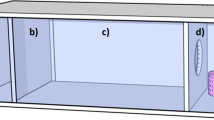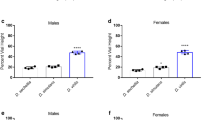Abstract
Locomotion is a primary means by which animals interact with the world. To understand the contribution of genotype × environment interactions to individual differences in D. melanogaster larval locomotion we investigated phenotypic sensitivity to environmental changes in four strains of this species and their F1 hybrids. We also investigated to what extent flexibility and plasticity of locomotion depend upon larval age. Specifically, we examined larval locomotion at 48 and 96 h of development on three different substrates. Locomotion was influenced by the structure of the substrate, but this depended on both the genotype and larval age. At 48 h of larval development phenotypic variation in locomotion was attributable to both genotype × environment interactions and genotypic differences among the larvae, while at 96 h of age, differences were mainly due to genotype × environment interactions. An analysis of variance of the 4 × 4 diallel cross made at 48 and 96 h of development showed, depending on the cross, either dominance to increase/decrease locomotion, overdominance to increase/decrease locomotion, or no dominance to increase/decrease locomotion. Furthermore, the diversity of behavioral responses in the F1 hybrids was greater at 96 than at 48 h of larval development. Our results demonstrate that genotype × environment interactions result in plasticity of D. melanogaster larval locomotion, which makes sense in light of the fact that larvae, in the wild, develop in heterogeneous and rapidly changing environments.

Similar content being viewed by others
References
Anholt RRH, Mackay TFC (2004) Quantitative genetic analysis of complex behaviours in Drosophila. Nature Rev Genet 5:838–849
Arizmendi C, Zuleta V, Ruiz-Dubreuil G, Godoy-Herrera R (2008) Genetics analysis of larval foraging in Drosophila funebris. Behav Genet 38:525–530
Ashburner M, Golic KG, Hawley RS (2005) Drosophila. A laboratory handbook. Cold Spring Harbor Laboratory Press, New York
Beltramí M, Medina-Muñoz MC, Arce D, Godoy-Herrera R (2010) Drosophila pupation in the wild. Evol Ecol 24:347–358
Burcher LM, Plomin R (2008) The nature of nurture: a genomewide association scan for family chaos. Behav Genet 38:348–360
Burdick AB (1954) New medium of reproductivity quality stable at room temperature. Drosoph Inf Serv 28:170
David JR, Allemand R, Van Herrewege J, Cohet Y (1983) Ecophysiology: abiotic factors. In: Ashburner M, Carson HL, Thompson JL (eds) The genetics and biology of drosophila, vol 3. Academic Press, London, pp 105–170
de Bono M, Sokolowski MB (2007) Foraging in flies and worms. In: North G, Greenspan RJ (eds) Invertebrate neurobiology. Cold Spring Harbor Laboratory Press, Cold Spring Harbor, pp 437–466
Falconer DS, Mackay TFC (1996) Introduction to quantitative genetics, 4th edn. Longman Group Ltd, Edinburgh Gate, Harlow
Fogleman JC, Starmer WT, Heed WB (1981) Larval selectivity for yeast species by Drosophila mojavensis in natural substrates. Proc Natl Acad Sci 78:4435–4443
Godoy-Herrera R, Connolly K (2007) Organization of foraging behavior in larvae of cosmopolitan, widespread, and endemic Drosophila species. Behav Genet 37:595–603
Godoy-Herrera R, Burnet B, Connolly K, Gogarty J (1984) The development of locomotr activity in Drosophila melanogaster larvae. Heredity 52:63–75
Gould SJ (1977) Ontogeny and phylogeny. Harvard University Press, Cambridge, MA
Green CH, Burnet B, Connolly K (1983) Organization and patterns of inter-and intraspecific variation on the behaviour of Drosophila larvae. Anim Behav 31:282–291
Hayman BI (1954) The theory and analysis of diallel crosses. II. Genetics 39:767–789
Lynch M, Walsh JB (1998) Genetics and analysis of quantitative traits. Sinauer Associates Inc Publishers, Sunderland, MA
Mather K, Jinks JL (1971) Biometrical genetics. The study of continuous variation. Chapman and Hall, London
Medina-Muñoz MC, Godoy-Herrera R (2004) Dispersal and prepupation behavior of Chilean sympatric Drosophila species that breed in the same site in nature. Behav Ecol 16:316–322
Osborne KA, Robichon A, Burgess E, Butland S, Shaw RA, Coulthard A, Pereira HS, Greenspan RJ, Sokolowski MB (1997) Natural behavior polymorphism due to a cGMP-dependent protein kinase of Drosophila. Science 277:834–836
Ruiz-Dubreuil G, del Solar E (1983) A diallel análisis of gregarious oviposition in Drosophila melanogaster. Heredity 70:281–284
Ruiz-Dubreuil G, Burnet B, Connolly K, Furness K (1996) Larval foraging behaviour and competition in Drosophila melanogaster. Heredity 76:55–64
Sambandam D, Carbone MA, Anholt RRH, Mackay TFC (2009) Phenotypic plasticity and genotype by environment interaction for olfactory behavior in Drosophila melanogaster. Genetics 179:1079–1088
Sokolowski MB, Kent C, Wong J (1984) Drosophila larval foraging behaviour: developmental stages. Anim Behav 32:645–651
Sokolowski MB, Bauer SJ, Wai-Ping V, Rodriguez L, Wong L, Kent C (1986) Ecological genetics and behaviour of Drosophila melanogaster larvae in nature. Anim Behav 32:403–408
Starmer WT, Aberdeen V (1990) The nutritional importance of pure and mixed cultures of yeasts in the development of Drosophila mulleri larvae in Opuntia tissues and its relationship to host plant shifts. In: Barker JSF, Starmer WT, MacIntyre RJ (eds) Ecological and evolutionary genetics of drosophila. Plenum, New York, pp 145–160
Starmer WT, Heed WB, Rockwood-Sluss ES (1977) Extension of longevity in Drosophila mojavensis by environmental ethanol: differences between subraces. Proc Natl Acad Sci 74:387–391
Zar JH (1984) Biostatistical analysis, 2nd edn. Prentice-Hall, Englewood Cliffs, NJ
Acknowledgments
We would like to thank Dr Susi Koref-Santibañez for her comments and suggestions concerning the manuscript. Thanks are also extended to “Sin Fronteras: Creativity without borders” for help in preparation of the manuscript. Thanks are also due to FONDECYT 1100110 for financial support. R.G-H. is also indebted to his wife Tatiana Márquez for her help in preparation of the Tables and Figure.
Author information
Authors and Affiliations
Corresponding author
Additional information
This paper is dedicated to Dr Barrie Burnet and Dr Lynn Burnet.
Edited by Yong-Kyu Kim.
Rights and permissions
About this article
Cite this article
Del Pino, F., Salgado, E. & Godoy-Herrera, R. Plasticity and Genotype × Environment Interactions for Locomotion in Drosophila melanogaster Larvae. Behav Genet 42, 162–169 (2012). https://doi.org/10.1007/s10519-011-9490-1
Received:
Accepted:
Published:
Issue Date:
DOI: https://doi.org/10.1007/s10519-011-9490-1




